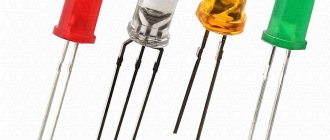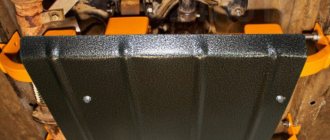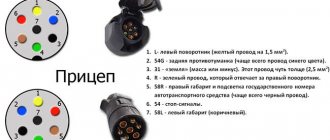Home / Lighting devices / LEDs
Back
Published: 05/17/2020
0
296
- On what principle does the circuit work?
- Is it possible to do it yourself? What will you need?
- Step-by-step manufacturing instructions
Gradual lighting of LEDs is widely used in electrical tuning of cars and in the advertising business for decorating banners. To implement this technique without the help of professionals, you can use one of the schemes, taking it from the Internet. If you can’t make a block yourself, you can purchase it in a store.
It is difficult to make a device for smooth activation with your own hands without experience. It is necessary to understand the principle of operation of LEDs and electronic circuits. Savings will be a plus, since the cost of the manufactured device will be much lower than the cost of finished products.
Buy or make it yourself?
If you need it urgently or don’t have the desire or time to assemble a block for smooth switching on of LEDs with your own hands, then you can buy a ready-made device in a store. The only negative is the price. The cost of some products, depending on the parameters and manufacturer, can exceed several times the cost of a device made by yourself.
If you have the time and especially the desire, then you should pay attention to long-developed and time-tested schemes for smoothly turning on and off LEDs.
Principle of operation
power unit
To reduce wear on the filament, it is necessary to smooth out the jump, that is, to ensure smooth switching on and off of incandescent lamps. This means that you need an optimal ratio of the coil temperature and voltage, which will lead to normalization of the mode and, as a result, maintaining the functionality of the light device for a longer period. A diagram for smooth switching on of incandescent lamps can help; to be specific, you need to use a special power supply. Within a short time, the filament will heat up to the required limit of both temperature and voltage set by man.
Power supply for smooth start
If you set the power level to 180 V, then naturally the luminous flux will decrease by two-thirds, but by installing more powerful consumers it is possible to achieve the desired level of illumination, ensuring a smooth start of incandescent lamps, while saving energy and extending the service life of the incandescent lamps. light device.
When purchasing such a unit for smoothly switching on incandescent light bulbs, you need to clarify whether the device is resistant to high voltage surges in the network. Ideally, the maximum margin for this parameter should exceed 25–30%. And the higher the level of this indicator, the larger the device will be. This fact must be taken into account, because the soft start unit must be located somewhere.
Soft start device
The operating algorithm of the device for smoothly switching on a 220 V incandescent lamp is the same as that of the power supply, but the UPVL has significantly smaller dimensions, thanks to which it can be placed under the cap of a ceiling lamp, and directly behind the switch (in the same socket box), as well as in junction box.
This device must be connected to a 220 V network in series, connecting to a phase wire. And provided that the voltage to the lamp is supplied at 12 V or 24 V, the UPVL requires its serial inclusion in the circuit before the step-down transformer.
Diagram and appearance of the lamp soft start device
Dimming
The use of dimmers or dimmers in everyday life is widespread. These devices are also mounted in incandescent lamp circuits and control the voltage supply level to the lamp either mechanically (by rotating the handle) or automatically. They are most often inserted into the circuit in place of a standard switch (although there are more complex models that are also installed to supply voltage to an apartment).
The simplest dimmers have a rotary adjustment mechanism. In such a device, it is possible to adjust the supply from zero to the maximum voltage in the network. There are such devices with remote, touch, sound and automatic (using a timer) control.
The Basics of Soft Start
Let's start with the basics and remember what an RC circuit is and how it is related to the smooth ignition and decay of the LED. Look at the diagram.
It contains only three components:
- R – resistor;
- C – capacitor;
- HL1 – backlight (LED).
The first two components make up the RC circuit (the product of resistance and capacitance). Increasing the resistance R and capacitance C of the capacitor increases the ignition time of the LED. When decreasing, the opposite is true.
We will not delve into the basics of electronics and consider how physical processes (more precisely, current) occur in this circuit. It is enough to know that it underlies the operation of all smooth ignition and extinction devices.
The considered principle of RC delay underlies all solutions for smooth turning on and off of LEDs.
Photo of lamps switching on smoothly
Surge protection - classification of devices, connection diagrams, features of electrical installation workIntermediate relay - classification, purpose, connection and operation features (Instructions)
Connecting a difavtomat - diagrams, installation rules and do-it-yourself installation features. Step-by-step instructions for a novice electrician!
Read here! Resistor - main parameters, labeling and modern types of device (Instructions + table)
Schemes for smooth switching on and off of LEDs
There is no point in disassembling cumbersome circuits, because... Most problems can be solved by simple devices operating on elementary circuits. Let's consider one of these schemes for smoothly turning on and off LEDs. Despite its simplicity, it has a number of advantages, high reliability and low cost.
Consists of the following parts:
- VT1 – field effect transistor IRF540;
- C1 – capacitor with a capacity of 220 mF and a voltage of 16V;
- R1, R2, R3 – resistors with a nominal value of 10, 22, 40 kOm, respectively;
- LED – light-emitting diode.
Operates from a voltage of 12 Volts according to the following algorithm:
- When the circuit is connected to the power circuit, current flows through R2.
- At this time, C1 gains capacity (charges), which ensures the gradual opening of the field switch VT
- Increasing gate current (pin 1) flows through R1, and causes the field drain VT to gradually open
- The current goes to the source of the same field switch VT1 and then to the LED.
- The LED gradually increases its light emission.
The LED dims when the power is removed. The principle is the opposite. After turning off the power, capacitor C1 begins to gradually transfer its capacitance to resistances R1 and R2.
The discharge rate, and thus the smooth decay rate of the LED, can be adjusted by the nominal resistance R3. Experiment to understand how the rating affects the speed of LED ignition and decay. The principle is the following - higher resistance, slower attenuation, and vice versa.
The main element is the field-effect n-channel MOSFET transistor IRF540, all other semiconductor devices play an auxiliary role (piping). It is worth noting its important characteristics:
- drain current: up to 23 Amperes;
- polarity: n;
- drain-source voltage: 100 Volts.
More detailed information, including current-voltage characteristics, can be found on the manufacturer’s website in the datasheet.
Improved version with the ability to customize the time
The option discussed above assumes the use of a device without the ability to adjust the ignition time and LED attenuation. And sometimes it is necessary. To implement it, you just need to supplement the circuit with several elements, namely R4, R5 - adjustable resistances. They are designed to implement the function of adjusting the time of complete switching on and switching off the load.
The considered schemes of smooth ignition and decay are perfect for implementing designer lighting in a car (trunk, doors, foot area of front passengers).
Another popular scheme
The second most popular scheme for smoothly turning on and off LEDs is very similar to the two discussed, but they are very different in operating principle. Switching on is controlled by minus.
The circuit has been widely used in places where one part of the contacts is connected to the negative and the other to the positive.
Differences between the scheme and those discussed earlier. The main difference is a different transistor. The field switch must be replaced with a p-channel one (the markings are shown in the diagram below). You need to “turn over” the capacitor, now the plus of the capacitor will go to the source of the transistor. Do not forget, the modified version has power with reverse polarity.
Scheme of smooth ignition and attenuation of LEDs
Hello everyone, today I want to share a scheme for smooth switching on and smooth decay of LEDs. This circuit can be plugged in wherever your heart desires; I present a circuit with both a control minus and a control plus. The scheme does not require any additional settings and works immediately.
The principle of operation of the circuit:
The control “plus” is supplied through a 1N4148 diode and a 4.7 kOhm resistor to the base of the KT503 transistor. At the same time, the transistor opens, and through it and the 68 kOhm resistor the capacitor begins to charge. The voltage on the capacitor gradually increases, and then through a 10 kOhm resistor it is supplied to the input of the field-effect transistor IRF9540. The transistor gradually opens, gradually increasing the voltage at the output of the circuit. When the control voltage is removed, the KT503 transistor closes. The capacitor is discharged to the input of the field-effect transistor IRF9540 through a 51 kOhm resistor. After the capacitor discharge process is completed, the circuit stops consuming current and goes into standby mode. The current consumption in this mode is negligible.
Circuit with control minus:
IRF9540N pinout marked
Circuit with control plus:
IRF9540N and KT503 pinout marked
This time I decided to make the circuit using the LUT method (laser ironing technology). I did this for the first time in my life, I’ll say right away that there is nothing difficult. For work we will need: a laser printer, glossy photo paper (or a page from a glossy magazine) and an iron.
COMPONENTS:
Transistor IRF9540N Transistor KT503 Rectifier diode 1N4148 Capacitor 25V100µF Resistors: - R1: 4.7 kOhm 0.25 W - R2: 68 kOhm 0.25 W - R3: 51 kOhm 0.25 W - R4: 10 kOhm 0.25 W Single-sided fiberglass and ferric chloride Screw terminal blocks, 2 and 3-pin, 5 mm
If necessary, you can change the ignition and decay time of the LEDs by selecting the value of resistance R2, as well as selecting the capacitance of the capacitor.
??????????????????????????????????????? JOB: ????????????????????????????????????????? ?1?In this post I will show in detail how to make a board with a control plus. The board with the control minus is made in a similar way, even a little simpler due to the smaller number of elements. We mark the boundaries of the future board on the PCB. We make the edges a little larger than the pattern of the paths, and then cut them out. There are many ways to cut PCB: with a hacksaw, metal scissors, using an engraver, and so on.
Using a utility knife, I made grooves along the marked lines, then sawed them out with a hacksaw and sharpened the edges with a file. I also tried using metal scissors - it turned out to be much easier, more convenient and dust-free.
Next, sand the workpiece under water with P800-1000 grit sandpaper. Then we dry and degrease the surface of the board with 646 solvent using a lint-free cloth. After this, you must not touch the surface of the board with your hands.
?2?Next, using the SprintLayot program, open and print the diagram on a laser printer. You only need to print the layer with tracks without markings. To do this, when printing in the program, at the top left in the “layers” section, uncheck unnecessary boxes. Also, when printing, in the printer settings we set high definition and maximum image quality. I uploaded the program and slightly modified diagrams for you to Yandex.Disk.
Using masking tape, glue a glossy magazine page/glossy photo paper (if their size is smaller than A4) onto a regular A4 sheet and print our diagram on it.
I tried using tracing paper, glossy magazine pages and photo paper. It is most convenient, of course, to work with photographic paper, but in the absence of the latter, even magazine pages will do just fine. I don’t recommend using tracing paper - the design on the board is printed very poorly and will turn out unclear.
?3?Now we warm up the PCB and attach our printout. Then use an iron with good pressure to iron the board for several minutes.
Now let the board cool completely, then put it in a container of cold water for a few minutes and carefully remove the paper from the board. If it doesn’t come off completely, then roll it up slowly with your fingers.
Then we check the quality of the printed tracks, and touch up the bad places with a thin permanent marker.
?4?Using double-sided tape, glue the board onto a piece of polystyrene foam and place it in a ferric chloride solution for several minutes. The etching time depends on many parameters, so we periodically remove and check our board. We use anhydrous ferric chloride, dilute it in warm water according to the proportions indicated on the package. To speed up the etching process, you can periodically shake the container with the solution.
After the unnecessary copper has been removed, we wash the board in water. Then, using a solvent or sandpaper, remove the toner from the tracks.
?5?Then you need to drill holes for mounting the board elements. To do this, I used a drill (engraver) and drills with a diameter of 0.6 mm and 0.8 mm (due to the different thickness of the legs of the elements).
?6?Next you need to tin the board. There are many different ways, I decided to use one of the simplest and most accessible. Using a brush, we lubricate the board with flux (for example LTI-120) and tin the tracks with a soldering iron. The main thing is not to keep the soldering iron tip in one place, otherwise the tracks may come off due to overheating. We take more solder onto the tip and move it along the path.
?7?Now we solder the necessary elements according to the diagram. For convenience, in SprintLayot I printed out a diagram with symbols on plain paper and, when soldering, checked the correct arrangement of the elements.
?8?After soldering, it is very important to completely wash off the flux, otherwise there may be short spots between the conductors (depending on the flux used). First, I recommend thoroughly wiping the board with 646 solvent, and then rinsing it well with a brush and soap and drying it.
After drying, we connect the “constant plus” and “minus” of the board to the power supply (“control plus” is not touched), then instead of the LED strip we connect a multimeter and check if there is voltage. If at least some voltage is still present, it means there is a short somewhere, perhaps the flux was not washed off well.
PHOTOS:
Shrinked the board
VIDEO: ????????????????????????????????????????? I T O G: ???????????????????????????????????????? I am satisfied with the work done, although I spent quite a lot of time. The process of making boards using the LUT method seemed interesting and uncomplicated to me. But, despite this, in the process of work I probably made all the mistakes that were possible. But, as they say, you learn from mistakes.
Such a board for smooth ignition of LEDs has a fairly wide range of applications and can be used both in a car (smooth ignition of angel eyes, instrument panels, interior lighting, etc.), and in any other place where there are LEDs and a 12V power supply. For example, in illuminating a computer system unit or decorating suspended ceilings.
Boards in .lay format
Source.











